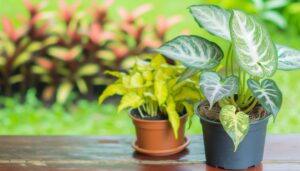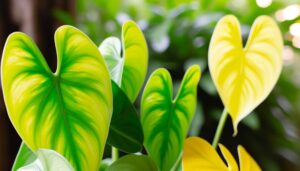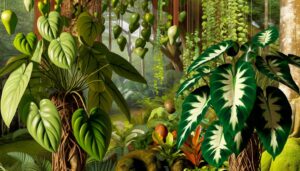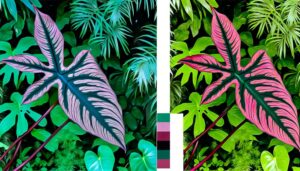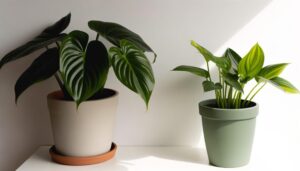Philodendron Lickety Split Vs Xanadu: Key Diffrences!
Philodendron Lickety Split and Philodendron Xanadu, both developed through selective breeding, exhibit notable differences in leaf morphology and growth habits. Lickety Split has glossy, deeply lobed leaves and grows upright and compact, spreading 2-4 feet.
Xanadu features muted, smooth-edged leaves and grows bushier, spreading 3-5 feet horizontally. Both thrive under bright, indirect sunlight but differ in overall texture and chlorophyll concentration, affecting light absorption and transpiration.
Best care includes well-draining soil, balanced moisture, and 65-80°F temperatures with 60-80% humidity. Each species enhances indoor air quality and provides aesthetic value.
Continue to understand more distinctions and their care requirements.
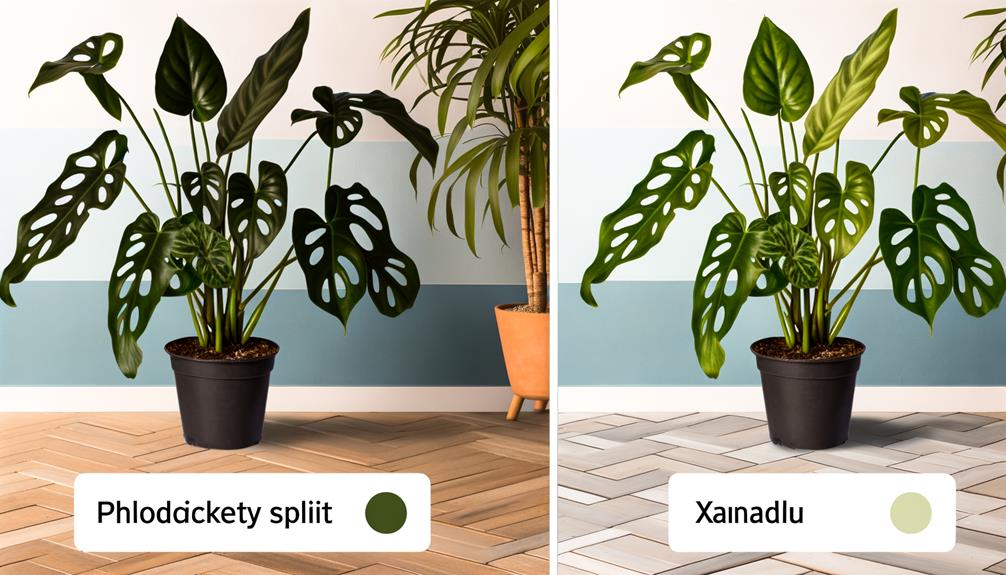
Key Takeaways
- Philodendron Lickety Split has deeply incised, glossy green leaves, while Xanadu features smooth-edged, muted green leaves.
- Lickety Split grows upright and compact, whereas Xanadu spreads horizontally with a bushier growth habit.
- Lickety Split typically reaches 2-3 feet in height, and Xanadu can grow 2-4 feet tall.
- Both species thrive in bright, indirect sunlight and require well-draining soil with balanced moisture.
- Ideal temperature for both is between 65°F and 80°F, with a humidity range of 60% to 80%.
Philodendron Lickety Split vs Xanadu: Comparing Leaf Shape, Growth, and Care Needs
| Characteristic | Philodendron Lickety Split | Philodendron Xanadu |
|---|---|---|
| Leaf Shape | Deeply lobed, glossy leaves with frilly edges. | Lobed leaves with a more symmetrical, less frilly shape. |
| Size | Can grow larger, up to 5 feet tall with a wide spread. | More compact, typically reaching 2-4 feet in height. |
| Growth Habit | Upright growth with a tendency to spread outwards. | Upright and clumping growth, maintaining a neat form. |
| Leaf Texture | Shiny, with a slightly more rugged, textured appearance. | Smoother, with a more uniform texture. |
| Light Requirements | Prefers bright, indirect light but tolerates moderate light. | Thrives in bright, indirect light; can handle low light. |
| Care Difficulty | Low-maintenance, great for beginners. | Similarly easy to care for, ideal for low-effort plant enthusiasts. |
| Native Region | Native to tropical rainforests in Central and South America. | Native to Brazil, commonly grown as an ornamental houseplant. |
Origins
Examining the origins of Philodendron ‘Lickety Split’ and Philodendron xanadu reveals distinct botanical histories and geographic distributions critical to understanding their unique characteristics. Philodendron ‘Lickety Split’ is a cultivar developed through selective breeding, primarily for ornamental purposes. Its genetic lineage is rooted in the broader Philodendron genus, native to the tropical regions of Central and South America.
In contrast, Philodendron xanadu, originally named Thaumatophyllum xanadu, hails from the subtropical forests of Brazil. It was discovered in the 1980s and later reclassified under the Philodendron genus. The ecological adaptations of these species to their native environments inform their growth habits, resilience, and care requirements in cultivation, offering insights into their botanical diversity and horticultural potential.
Appearance
The morphological distinction between Philodendron Lickety Split and Xanadu is most evident in their leaf shape, color, and texture.
Philodendron Lickety Split exhibits deeply lobed, serrated leaves with a vibrant green hue, whereas Philodendron Xanadu features more uniform, pinnatifid leaves that are also slightly glossy.
Both species possess different textural characteristics, with Lickety Split having a rougher surface compared to the smoother, more refined texture of Xanadu leaves.
Leaf Shape Comparison
Philodendron Lickety Split and Xanadu exhibit distinct leaf morphologies. Lickety Split features deeply lobed, ruffled leaves, while Xanadu presents more uniform, smooth-edged foliage. The Lickety Split’s leaves are characterized by their multiple, irregularly incised lobes, creating a textured, almost feathery appearance. In contrast, Xanadu’s leaves display a more symmetrical, palmate structure with evenly spaced lobes that provide a more streamlined aesthetic. This divergence in leaf architecture not only influences their visual appeal but also their functional aspects such as light interception and transpiration efficiency.
- Deeply incised lobes: Creates a dramatic, intricate visual effect.
- Smooth-edged foliage: Offers a sleek, polished look.
- Textural complexity: Enhances ornamental value.
- Symmetrical arrangement: Conveys a sense of order and balance.
- Distinctive silhouette: Differentiates each species uniquely.
Color and Texture
Regarding color and texture, Lickety Split displays a vibrant, glossy green surface with a slightly waxy finish, whereas Xanadu showcases a more muted green hue paired with a matte texture.
The Lickety Split’s leaves present an almost reflective quality due to their high chlorophyll concentration and waxy cuticle, which aids in water retention and pest resistance. In contrast, Xanadu’s matte leaves are characterized by a denser, less reflective epidermal layer, contributing to its subtler appearance.
This difference in surface texture impacts light absorption and transpiration rates, with Lickety Split being more efficient in humid environments. Xanadu’s subdued coloration and texture provide a more understated aesthetic, favoring environments with indirect light.
Both species exhibit unique adaptive traits in their respective textures and hues.
Leaf Shape
Leaf morphology plays a critical role in distinguishing Philodendron Lickety Split from Philodendron Xanadu. Each species exhibits unique characteristics in leaf shape and structure. Philodendron Lickety Split features deeply lobed, multi-segmented leaves that create a dramatic, intricate appearance. Conversely, Philodendron Xanadu presents a more compact, symmetrical leaf form with less pronounced lobes and a more uniform structure.
- Intricate lobes: Lickety Split’s leaves boast deeply divided lobes, evoking a sense of complexity.
- Symmetry: Xanadu’s leaves offer a balanced, symmetrical aesthetic.
- Dramatic form: The bold segmentation of Lickety Split leaves creates visual intrigue.
- Uniformity: Xanadu’s leaves provide a consistent, cohesive look.
- Distinct textures: Varied textures between the two species enhance their unique appearances.
Growth Habit
The growth habits of Philodendron Lickety Split and Philodendron Xanadu exhibit distinct variations when it comes to growth pattern, leaf morphology, and overall size and spread.
Philodendron Lickety Split tends to develop in an upright, clumping formation with deeply lobed, elongated leaves.
Meanwhile, Philodendron Xanadu displays a more compact, bushy growth with broader, less dissected foliage.
These variations greatly impact their suitability for various horticultural applications and indoor environments.
Growth Pattern Differences
Philodendron ‘Lickety Split’ displays a more upright and compact growth habit, while Philodendron ‘Xanadu’ tends to spread horizontally, creating a dense and wide foliage coverage.
The ‘Lickety Split’ grows vertically, forming a bushier structure with tightly clustered leaves. In contrast, ‘Xanadu’ expands laterally, producing a ground-covering effect which maximizes its spatial footprint.
This divergence in growth patterns notably influences their suitability for different indoor and landscape applications.
- Elegance: The upright growth of ‘Lickety Split’ adds vertical grace.
- Coverage: ‘Xanadu’ offers impressive ground-covering capability.
- Density: Both varieties provide lush, dense foliage.
- Versatility: Their distinct growth habits cater to diverse design needs.
- Aesthetics: Unique growth patterns contribute to their ornamental appeal.
Understanding these differences aids in selecting the appropriate plant for your environment.
Leaf Shape Comparison
Examining the distinct leaf morphologies of ‘Lickety Split’ and ‘Xanadu’ reveals further differentiations in their growth habits, essential for informed selection and cultivation practices. ‘Lickety Split’ features deeply lobed, serrated leaves with pronounced indentations, contributing to a more intricate and almost feathered appearance. This leaf morphology facilitates a sprawling growth habit, enhancing light capture and airflow.
Conversely, ‘Xanadu’ exhibits broader, less deeply lobed leaves with a more uniform and symmetrical structure. The compact, organized leaf shape of ‘Xanadu’ promotes a dense, bushy growth habit, ideal for space-constrained environments. These morphological differences not only influence aesthetic appeal but also impact physiological processes such as photosynthesis and transpiration, thereby affecting overall plant vigor and adaptability.
Size and Spread
Understanding the size and spread of ‘Lickety Split’ and ‘Xanadu’ is essential for optimizing their placement and maintenance within various horticultural settings. The ‘Lickety Split’ typically achieves a height of 2-3 feet with a spread of 2-4 feet, characterized by its expansive, deeply lobed leaves. Conversely, ‘Xanadu’ maintains a more compact stature, reaching heights of 2-4 feet and a spread of 3-5 feet, forming a dense, clumping habit. These growth habits are influenced by environmental variables such as light intensity and soil quality.
- Vibrant foliage enhancing interior landscapes
- Compact growth ideal for limited spaces
- Expansive spread creating lush, verdant displays
- Adaptable to diverse light conditions
- Low-maintenance, promoting sustainable gardening practices
Understanding these metrics aids in curating aesthetically pleasing and thriving garden designs.
Light Requirements
Optimal light conditions for both the Lickety Split and Xanadu varieties require bright, indirect sunlight to sustain their lush foliage and encourage healthy growth. Both philodendron species thrive under filtered light, which mimics their natural understory tropical habitat, reducing the risk of photoinhibition.
Exposure to direct sunlight can result in leaf burn and chlorosis, impairing photosynthetic efficiency to a great extent. These plants are adaptable to low light environments; however, suboptimal lighting can lead to etiolation, characterized by elongated stems and sparse foliage.
Utilizing artificial grow lights, especially full-spectrum LED lights, can enhance natural lighting conditions, ensuring consistent photoperiods essential for maintaining cellular processes. Regularly rotating the plants can also promote uniform light exposure, preventing asymmetrical growth patterns.
Watering Needs
Proper watering practices are crucial for the health and well-being of both Philodendron Lickety Split and Xanadu, requiring a balanced approach to moisture management. Both species benefit from consistent moisture, but overwatering can lead to root rot, a common issue that endangers plant vitality.
Best watering involves:
- Checking soil is moist but not waterlogged
- Allowing the top inch of soil to dry out between waterings
- Using well-draining containers to prevent excess moisture accumulation
- Noticing seasonal adjustments, reducing watering frequency in winter
- Monitoring plant responses to adjust watering schedules accordingly
Adopting these strategies guarantees that Philodendron Lickety Split and Xanadu receive sufficient hydration, promoting strong growth and minimizing the risk of pathogen proliferation.
Soil Preferences
Philodendron Lickety Split and Xanadu thrive in well-draining, aerated soil mixes rich in organic matter to support their root systems and prevent waterlogging. Ideal substrates include a mix of peat moss, perlite, and pine bark, which collectively enhance moisture retention while ensuring adequate drainage.
The inclusion of organic compost can further enrich the soil with essential nutrients, promoting robust plant growth. Soil pH should be maintained between 5.5 and 6.5 to optimize nutrient availability and uptake. Additionally, incorporating mycorrhizal fungi can enhance root health and efficiency in nutrient absorption.
Regularly monitoring soil moisture levels is essential to avoid conditions that predispose these Philodendrons to root rot and other fungal infections.
Temperature Tolerance
Both Philodendron Lickety Split and Xanadu exhibit ideal growth in temperature ranges between 65°F and 80°F, demonstrating moderate tolerance to fluctuations within this spectrum. These temperature conditions are important for maintaining best photosynthesis rates and metabolic activities.
However, temperatures below 55°F can induce chlorosis and stunt growth, while prolonged exposure above 85°F may lead to desiccation and stress responses.
- Enhanced leaf coloration at stable temperatures
- Increased susceptibility to pests at extreme temperatures
- Best enzymatic functions within recommended range
- Potential for thermal stress in non-ideal conditions
- Improved resilience with gradual temperature changes
Understanding these parameters allows for effective cultivation and ensures that these species thrive in both indoor and outdoor environments.
Humidity Needs
Best moisture levels are crucial for the physiological well-being and overall health of Philodendron Lickety Split and Xanadu, with a preference for environments maintaining relative moisture between 60% and 80%. This range ensures peak stomatal function, photosynthetic efficiency, and transpiration processes.
Low moisture can result in desiccation of leaf margins and reduced cellular turgor pressure, impairing growth. Conversely, excessive moisture may predispose these philodendrons to fungal and bacterial infections due to moisture accumulation on foliar surfaces.
Employing hygrometers to monitor ambient moisture can be beneficial, and using humidifiers or pebble trays can help achieve the desired microenvironment. Understanding and managing these moisture needs is critical for sustaining the robust morphology and vibrant foliage characteristic of these species.
Maintenance
Effective maintenance of Philodendron Lickety Split and Xanadu involves precise trimming methods, targeted feeding schedules, and attentive pest control to guarantee growth and health at its peak.
Regular trimming is essential to remove dead or yellowing leaves, promoting strong growth and preventing disease.
Feeding should be administered every other month with a balanced 20-20-20 NPK fertilizer to support nutrient uptake.
Soil should be well-draining to prevent root rot, and watering practices must be monitored to avoid waterlogging.
- Trim regularly: Encourages new growth and prevents disease.
- Every other month feeding: Maintains optimal nutrient levels.
- Well-draining substratum: Prevents root rot and enhances aeration.
- Uniform watering: Maintains soil moisture without waterlogging.
- Regular examinations: Early detection of issues guarantees timely intervention.
This all-encompassing approach ensures the plants thrive, showcasing their vibrant foliage.
Common Pests
Both Philodendron Lickety Split and Xanadu are susceptible to various pests, including common insect infestations such as aphids, spider mites, and mealybugs. Additionally, these species are prone to fungal disease issues like root rot and leaf spot, which can severely compromise plant health.
Effective pest management and early detection are essential in maintaining the health of these philodendrons.
Common Insect Infestations
Philodendron Lickety Split and Xanadu, despite their robust nature, are susceptible to several common insect infestations, including spider mites, mealybugs, and aphids. These pests can cause significant physiological stress to the plants, leading to chlorosis, stunted growth, and even plant death if unchecked.
The following common infestations are frequently observed:
- Spider Mites: Minuscule arachnids that cause stippling and yellowing of leaves.
- Mealybugs: White, cotton-like insects that excrete honeydew, encouraging sooty mold growth.
- Aphids: Sap-sucking insects that lead to curled, distorted foliage.
- Scale Insects: Hard-shelled pests that feed on plant sap and weaken the host.
- Whiteflies: Small, winged insects that cause leaf yellowing and wilting.
Effective management through regular monitoring and appropriate insecticidal treatments is essential.
Fungal Disease Issues
In addition to insect infestations, Philodendron Lickety Split and Xanadu are also vulnerable to various fungal diseases, which can further compromise their health and strength. Common fungal pathogens affecting these species include Phytophthora, Pythium, and Rhizoctonia. These fungi typically thrive in overly moist environments, leading to root rot, leaf spots, and blight.
Phytophthora and Pythium species are notorious for causing root rot, characterized by dark, mushy roots and chlorotic foliage. Rhizoctonia, on the other hand, often results in stem rot and damping-off in seedlings. Effective management involves ensuring proper drainage, avoiding waterlogged conditions, and applying fungicides when necessary.
Early detection and prompt treatment are essential to prevent widespread damage and maintain plant vitality.
Popular Uses
Frequently utilized in both residential and commercial landscaping, Philodendron Lickety Split and Xanadu serve as versatile ornamental plants due to their distinct foliage and robust growth characteristics. Their adaptability to various environments and minimal maintenance requirements make them highly sought after.
Their lush, deeply lobed leaves add an exotic touch to any setting, enhancing aesthetic appeal.
- Enhanced air quality: Both plants contribute to indoor air purification by removing toxins.
- Visual impact: Their unique leaf structures create striking visual interest.
- Low maintenance: These species require minimal care, making them ideal for busy individuals.
- Versatile placement: Suitable for indoor and outdoor use, adaptable to different light conditions.
- Mood elevation: The presence of greenery has been scientifically proven to improve psychological well-being.
Conclusion
In the grand botanical theatre, Philodendron ‘Lickety Split’ and ‘Xanadu‘ stand as titans of tropical foliage. Their divergent origins, leaf morphology, and growth habits cater to a spectrum of horticultural preferences.
While ‘Lickety Split’ thrives in moderate light with its deeply lobed leaves, ‘Xanadu’ flourishes in brighter environments with its more compact form. Both demand high humidity and meticulous care.
Ultimately, their value is dictated not by their similarities, but by the unique niches they occupy in the plant kingdom.

